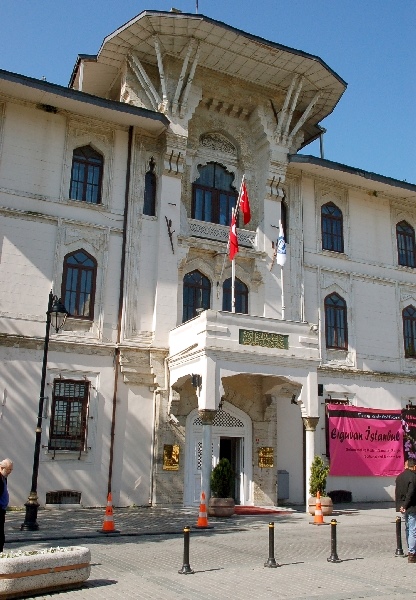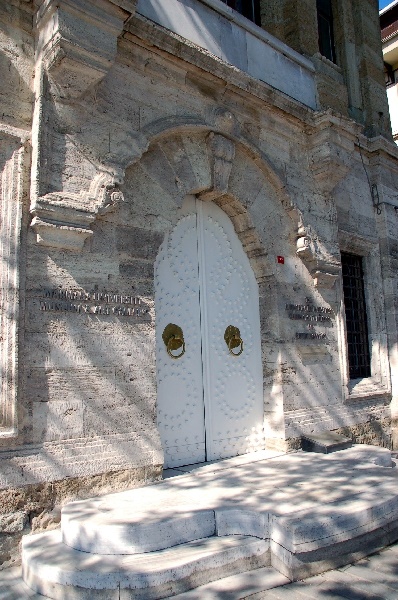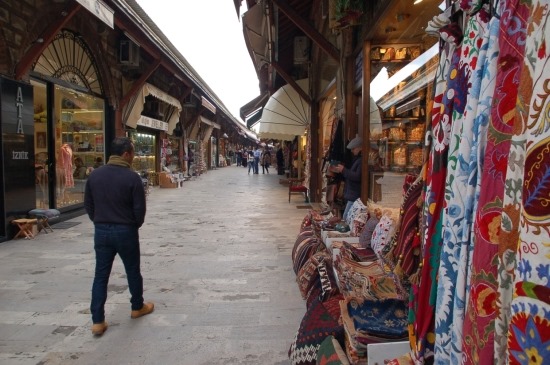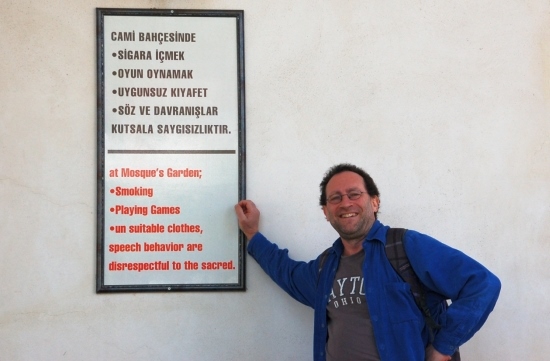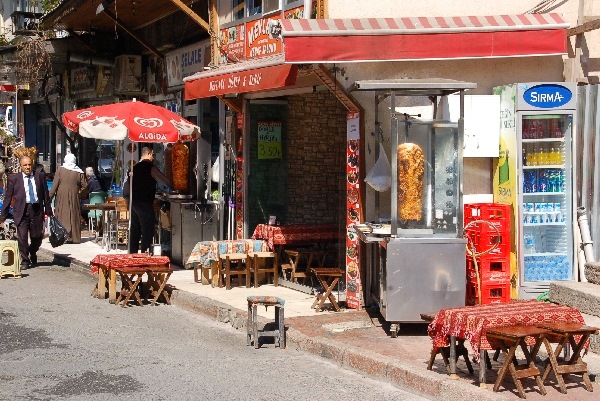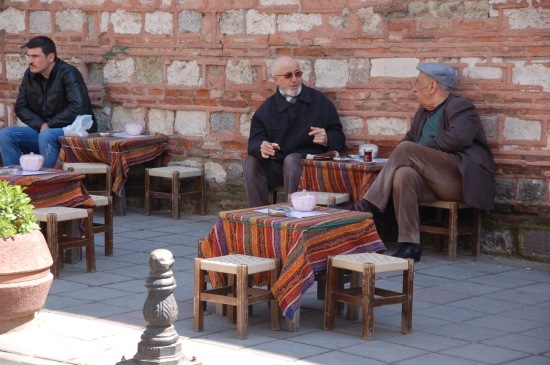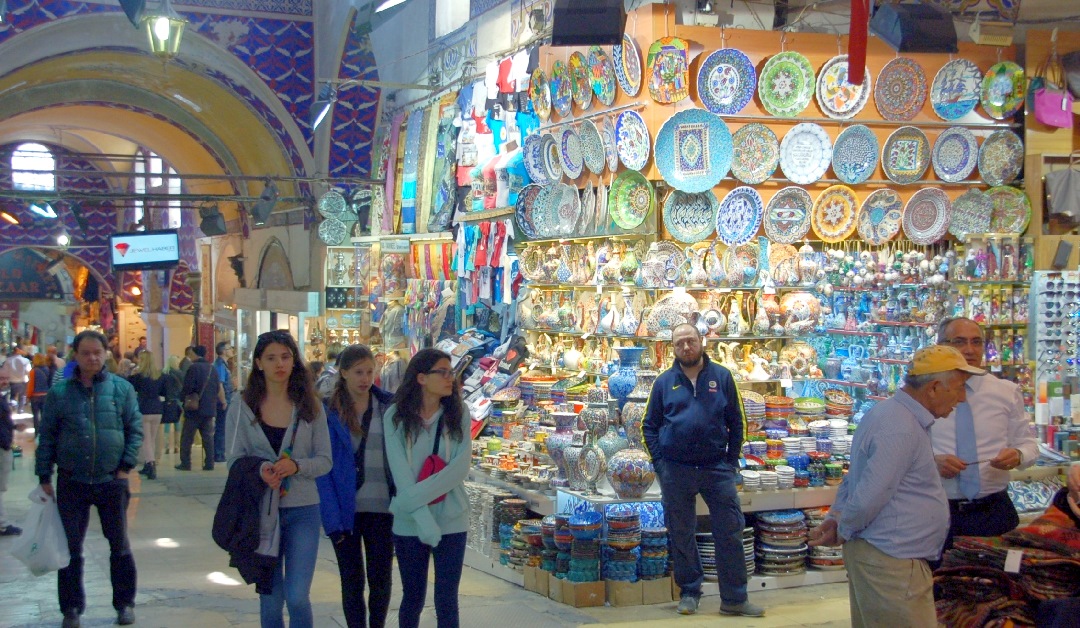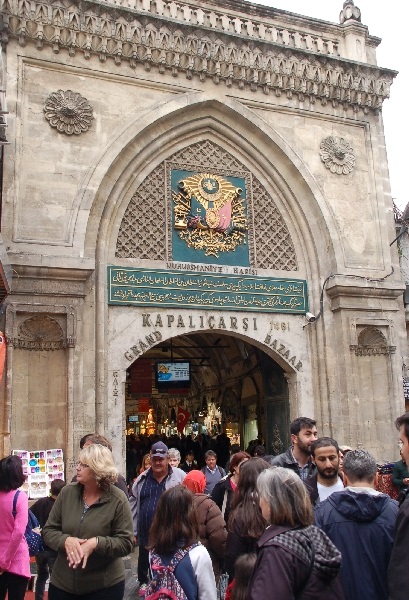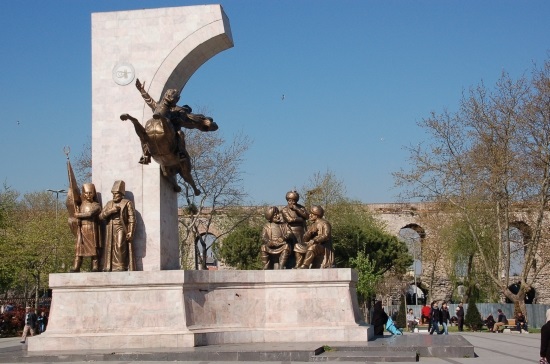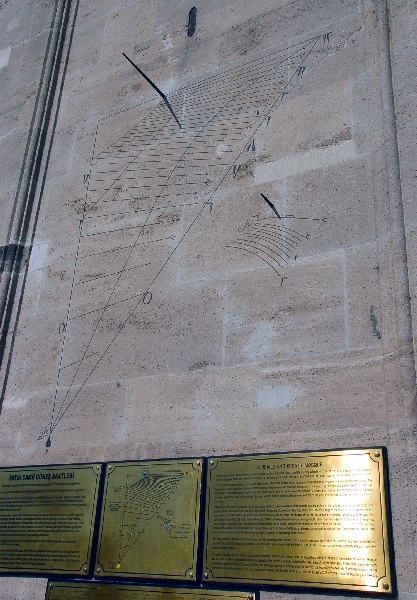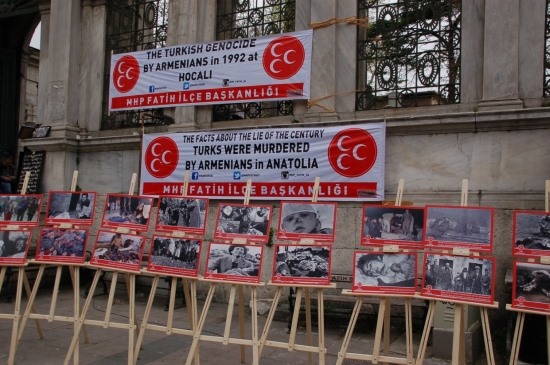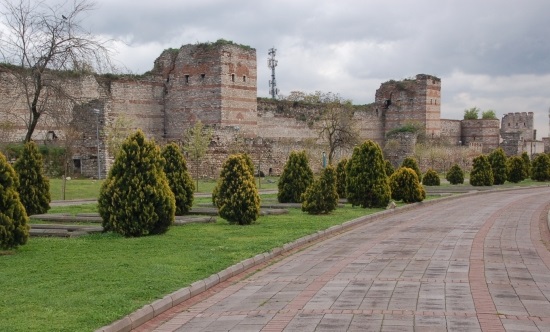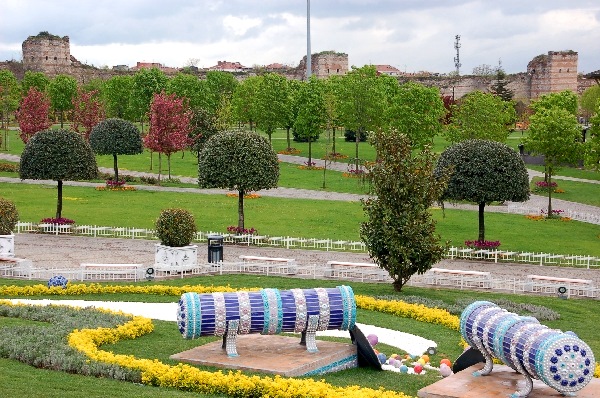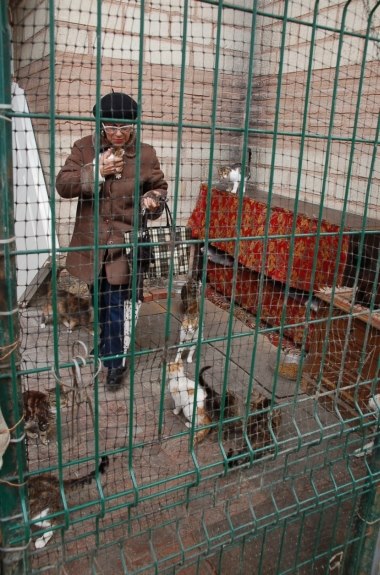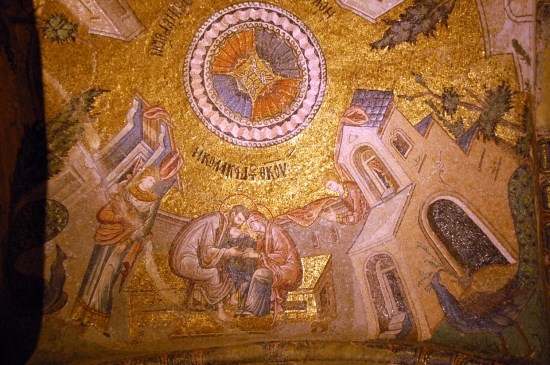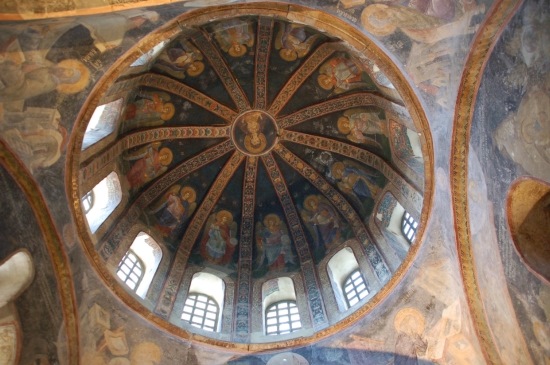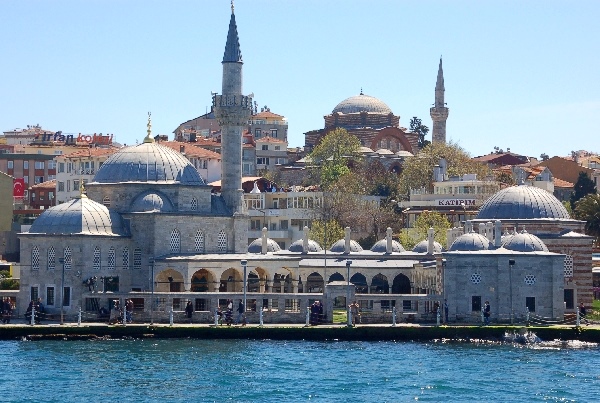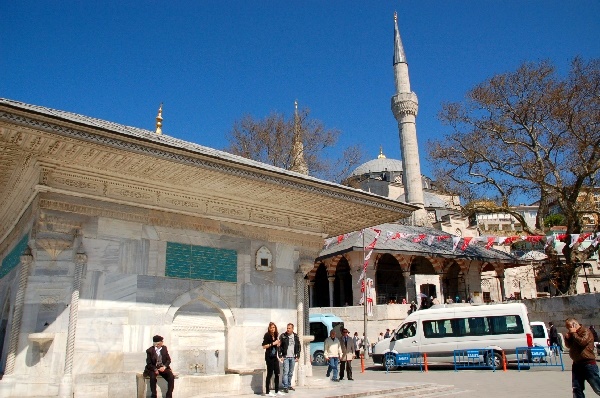World traveler Clown Tom Bolton
Adventure stories & photos

Tom’s trip to Turkey part 2
Istanbul continued – Near the Blue Mosque
Hippodrome obelisks on Sultan Ahmet Square
These are the Hippodrome obelisks which stand on a rectangular plaza on the far side of the Blue Mosque from the Hagia Sophia. The one in the foreground is the oldest standing architectural artifact in Istanbul. Brought to Istanbul by a Byzantium ruler Theodius the Great in 390 A.D. it had been erected in 1490 B.C. at the Temple of Karnack in Luxor, Egypt. The obelisk is made of marble and looks like it was made recently. Also in the middle of Sultan Ahmet Square is a memorial fountain commemorating the visit of German emperor Wilhelm II in 1898.
That such a huge heavy thing was created in ancient times is more astounding when one realizes what one sees is only the upper third, having been divided for transport. The hippodrome had been an oblong stadium for horse and chariot racing and social events that rivaled the capacity of modern football or soccer stadiums. The Ottomans found little use for such pastimes and the stadium was demolished over time but the name is still commonly used for the plaza where it once stood although it is officially now the Sultan Ahmet Square. The bottom photos are from the building at the end of the square including a side entrance. I didn’t visit it but it is a Univeristy museum and gallery known as the Marmara Universitesi Cumhuriyet Muzesi.
Souvenir Bazaar, hotels behind Blue Mosque
Of course the bazaars are not the only place to find souvenirs in Istanbul. Just behind the Sultan Ahmet Mosque is a walking street with shops selling fancy rugs, tapestries, pillow cases etc. Saw some beautiful stuff but I was not in the market to buy much of anything on this trip. Most of the surrounding neighborhood was completely oriented towards tourists; hotels and shops that managed to charge extra high prices due to their proximity to the main sites of the Topkapi Palace, Hagia Sophi and Blue Mosque.
Crumbling buildings
From the Blue mosque it is a 5 minute walk to another small mosque known as the little Ayasofya. On the way I passed a number of such wooden houses which turned out to be a common site in Istanbul. Many houses are built of wood and have been left to run down. Some are literally falling apart but are still occupied. Others are empty and often partially burned. I hear that there are expensive suburbs yet right in the inner city one sees many buildings crumbling away next door to fancy ones or historical sites. One would think such property too valuable to let go but if it doesn’t capitalize on the tourist industry then there seems to be little incentive to invest in upkeep.
The Little Hagia Sophia Mosque
The little Hagia Sophia aka little Ayasofya aka Kücuk Ayasofya is a pleasant Mosque which would be a major tourist site in many cities but I saw few visitors when I went. It was also formerly a church and could be viewed as a warm up for the construction of the bigger Hagia Sophia, which was built shortly after by the same architects supported by ruler Justinian. Although there are similarities, there are also enough differences in design that one cannot say it is just a smaller version by any means. There was a funny sign outside of the Kücük Ayasofya saying all that is allowed that of course should read NOT allowed.
Northwest from the Little Hagia Sophia
Walking northwest from the Little Ayasofya, I stopped for an early lunch with my friend Pablo. There was nothing really special about the restaurant; it was more notable for being rather typical yet not as expensive as the average tourist place. Yet there so many such place that they tend to look alike. One sees grilled meat most everywhere but they also had a decent variety of mixed Mediterranean vegetables that I ate with rice for most of my meals. A common site around the town are quaint little tea stands. Not sure if they sold coffee as well, which was rather expensive.
Grand Bazaar
These are some of the many Grand Bazaar entrances. Although a major tourist attraction lots of locals also seem to go here for all sorts of products. Although there are lots of souvenirs for tourists the touts all seemed to be offering blue jeans. This shop by another Grand Bazaar entrance sold very nice textiles like tapestries and pillow cases. The store was small but built in marble in the style of a small mosque or museum.
Grand Bazaar souvenirs
There were plenty of souvenirs in the Grand Bazaar reflecting its history with ceramics, swords and firearms. Grand Bazaar ceramics were not just for mosaics but dishes, vases, flower pots, lamps etc.
Grand Bazaar architecture
The Grand Bazaar is a huge complex expanded, sometimes partially destroyed and rebuilt over centuries. It is characterized by endless archways. Much of it is almost hidden to sight. One often goes down narrow hallways that open to beautiful, multi-level courtyards.
Near the Grand Bazaar
Istanbul University main campus
Near the Grand Bazaar is one of the main Istanbul University campuses or better said; the campus of one of the dozens of Istanbul Universities. This building was a majestic entrance way but was controlled and only students and other people connected with the University were allowed inside. Not sure if this was just a normal precaution or if Islamic militants ideology made such institutions of learning feel threatened. Not surprising, there were a lot of book shops in the area.

Süleymaniye Mosque Plaza
Near the University was the Süleymaniye Mosque, which is supposed to be rather significant but it was mostly obscured by renovation work and it seemed to be time for an official prayer or something inside when we went by so we were not able to go in. But the large plaza next to it seemed to be a popular place for people selling food for the pigeons. One used to see this in more places around the world but eventually it has been disallowed due to hygiene. Nothing like having hundreds of pigeons shitting on the same spot every day.
Rustem Pasa Mosque
North from the University area one comes to the Rustem Pasa Mosque. The first 2 photos to the left show the north sides including a view from a nearby cafe. Other views are from the entance and to the side. The design is a real icon of Istanbul since it is easily seen standing out on the hill over the Golden Horn.
Rustem Pasa Cami interior & views
The Rustem Pasa Cami interior was not as ornate as some of the others in Istanbul. It is however majestic in its design and size and includes a cemetary. The view from the mosque however was one of the better ones in Istanbul looking over the Golden Horn. Just below are the domes of the Haman or baths also connected to the mosque were buildings for a religious school and kitchen. I never found the time or money to visit a Haman while in Istanbul. The ones I saw were not cheap and seemed to be cashing in on the western preoccupation with anything one can attach the label “wellness” to. Yet they are prevalent and many of them advertise that they have been in business for hundreds of years, so locally not just a new fad.

Squalor west of Rustem Pasa Mosque
Not far from the Rustem Pasa mosque was another large brick mosque and also signs of urban decay; buildings literally falling down and signs of squalor. These girls nearby seemed never the less to be very curious and friendly about the tourists wandering the backstreets of this run down part of the neighborhood.
Fatih Anit Park & Valens Aqueduct
Fatih Anit Park with the Valens Aqueduct in background. The aqueduct was built by the Roman emperor Valens, finished in 368 A.D. and what remains here is almost a kilometer long but belonged to a system of over 250 kilometers of canals and aqueducts carrying water from the regions west of the city. The system was built progressively during the Roman times and the water stored in numerous reservoirs and cisterns in the city.
Lacking sources of fresh ground water, Istanbul water supply seemed to be a significant factor in its ability to expand and a target for enemies in times of war. Although fenced off, we saw 3 guys walking over the top of the aqueduct which looked kind of cool but I’m not into climbing buildings or base jumping or other extremely risky adventures. Fatih Anit Park was a fairly big space in a busy part of town. There are sections of grass where some families even made picnics but most of it was a plaza but with plenty of benches for people to meet and chat like these old guys.
Imam at mosque
This seemed to be an Imam on the steps of a mosque near the park. Not sure which mosque because is another one on virtually every block.
Fatih Sultan Mehmet Mosque
This is the Fatih Sultan Mehmet Turbesi Mosque, one of the bigger ones further west of Fatih Anit Park. Images include the entrance, old vendor selling semits pastries inside the walls, the washing station and the mosque mausoleum.
Turkish sweet shop
We stopped in this sweet shop shortly after leaving the Fatih Sultan Mehmet Turbesi mosque. Many of the items looked good but I was not in the mood for eating lots of sugar during my trip and find Turkish delight to be too sweet for my taste anyway.
Seyh Ebulvefa Mosque
Seyh Ebulvefa Mosque was more of a mid-sized place that I found appealing. The style of architecture seemed to be prevalent
in Istanbul although many of the biggest mosques seemed to be built out of solid stone, rather than bricks, on the exterior anyway.
Anti-Armenian demonstration
In front of yet another mosque there was an anti-Armenian protest. There had been political statements by some world leaders in recent days clarifying the reality of the Armenian genocide attempt by the Turks. Although documented beyond any degree of doubt, many Turks take insult to even have the subject brought up. Never mind that Hitler referred to it as evidence that the world would not be concerned with his intended extermination of the Jews. Here they were repeating the same propaganda once used to justify the slaughter of the Armenians by claiming the Turks were the actual victims. Such displays of hateful intolerance make me happy that Germans at least own up to what the Nazis did and openly denying it is a crime.
Communist Party activism
Although there had been political turmoil over the past year, I did see signs promoting communist groups and like in many countries, the first of May is celebrated, as advertised on this poster, as a day for labor and quasi if not outright support for communism. I assume such fringe parties are strictly controlled and basically tolerated by the present regime as a token opposition to create the appearance of democracy.
Sultan costumed man
This was a strange sight; a man in Sultan’s costume. He was in front of what seemed to be some kind of office with a group of people. I didn’t know what kind of event it was. Turkish boys get a celebration for when they are circumcised, a bit comparable to a bar mitzvah for Jewish boys. The celebrant is dressed in a similar type costume but why an adult man would do so is a bit of a mystery.
Street people, people watching
Like in any mega city, there are lots of not so well off people including a lot of refugees in Istanbul. Yet, I saw few adults outright begging but I wasn’t sure if it is more a legal or cultural restriction. More common is the selling of something and if you are really on a low scale then people would sell tissues for the nose like the woman to the left. And not that I want to lump groups randomly together but I’m including here some images of people I saw on the street. Not to suggest that they were street people, thy just caught my idea for people watching.
Old city walls
The city walls of Constantinople are the largest fortification of ancient times next to the Great Wall of China. First built by the Romans, they surrounded the entire city but the north to south fortification defending the western side was the most extensive. Constantine had conquered the city and built additional walls expanding the city limits to the west but eventually the city grew beyond and by the fifth century A.D. there was a new system known as the Theodosian Walls erected with double walls and a moat with towers about 80 meters apart.
Much of this fortification is still standing but is in bad repair. Earthquakes and war took their toll but most of the damages are from modern times as such fortifications won’t hold off air or artillery attacks and as there was no longer a need for such a defense, people started to steal the stones for building material. To the outside of the walls there is a promenade and green space. Climbing on and between the walls, one finds lots of broken bottles and signs of it being used as a public toilet. Yet there is still a palace standing that was built along a section of the western wall about a kilometer from the northern end.
Inner side of wall usages
On the inner side of the city walls there is generally just a narrow street separating it from other buildings. Passages through the wall are few and far between, the better for defense. There are even places where there are some shops, cafes, car repair garages or storage places build into inner side of the wall. There was even a space that was fenced off and a woman had built a residence for cats she had saved from the street. She said she had 15 cats living here yet others at home. Nice that they had some shelter and food but I wondered why they should be locked in if she didn’t want to have them live at home. Also common along the inside of the wall were extremely small houses.
Chora Church Museum
I had gone to walk along the northern half of the western wall but had missed the Chora church which is just a couple hundred meters away. I went back another day and near the entrance to the former church that is now a museum, there were many places to buy ceramic tiles. The Chora Church is not overly big compared to other religious buildings in Istanbul but its claim to fame is its extensive and intricate mosaics and frescoes. Unfortunately the main part of the church was closed off for renovation work but the fore and side chambers were impressive enough.
I don’t have an extreme wide angle lens for my camera to capture the domes and archways very well but felt content that my photos came out as well as they did as neither tripods or flashes are allowed. The church had originally been built as part of a Byzantine monastery that was outside of the city walls at that time. The Ottomans converted it to a mosque, saving it from destruction and in 1948 it was turned into a museum.
Ferry Ayvansaray – Eminönü – Üsüdar
Having walked the city wall to the north I ended up at the Ayvansaray ferry station which seemed to be home to a number of feral cats. This was my first opportunity to try a local ferry. It was not faster than a bus and the line I needed only ran once an hour at that time but it gave me a different perspective. One of the places that stood out on my ferry ride was the Phanar Greek College.
Another place one would not likely notice except from the water is the Istanbul Navel Museum. I did not have the chance to visit it but it was interesting to see a battleship and a submarine among other novelties anchored right in the city. Nearby was a large industrial area which looked to have been a harbor and storage area but seemed to be mostly abandoned.
Ferry from Eminönü to Usküdar
On my first ferry ride I got off at Eminönü. Another day I took the same ferry from Eminönü across the Bosporus to Üsküdar on the Asian side of the city. Although these ferries are used as mass transportation, rather than just for tourism – although there are also touristic boat tours – some had binoculars that one could use to get a closer look at the city sights.
The docks in Usküdar are a large area as there are many different ferries going to various local locations. The ticket office is surrounded by ATMs from different banks. The plaza at the dock area had stands from multiple political parties in campaign mode. Right across from the harbor area is the Mihirimah mosque.

Usküdar McDonalds
Walking inland from the mosque was a McDonalds, not something unusual except that they had a delivery service, something I haven’t seen elsewhere.
Mimar Sinana Camsisi
Farther along I came to a historical Haman or bath called Mimar Sinana Camsisi that had been converted into a small shopping mall. There was a large plaza next to the Mimar Sinana Camsisi where there were multiple shoe shiners that seem to have a tradition of a special style stand. One noticed that the people in Üsküdar seemed more middle class and conservative and less cosmopolitan than in central Istanbul.
Üsküdar street market
Eventually I let the main street I was following and found myself in a street market. There were endless stands with food, clothes and household products like pots, pans, brooms etc. set up in addition to the shops. I felt almost claustrophobic as it was crowded with 95% women shoppers and I found it went on and on, although I was trying to find my way back. After I got out of this maze, I decided against going farther although there should have been a couple of more significant old mosques to see.
Street clowns
On my way back to the ferry back I saw this pair of clowns in a cafe. I was curious if they were doing some kind of street performance as I had only seen musicians at various places. Unfortunately, I didn’t really have time to strike up a conversation even if we might have been able to communicate. I had also found a group of Istanbul performers including jugglers on Facebook but never got a response to my question about if they had a regular meeting place.
So, those were just a few tales from my many travels over the last thirty and something years. I hope you've enjoyed another side of a traveling clown! If you want, write me an email or better yet, book my show or set a link to this website or just state me as the beneficiary of your will!
To book or see more information about Tom's clown show and entertainment, visit one or both of his clown websites:
Clown Stuttgart www.clowntombolton.com
Clown juggler Stuttgart, Gremany www.clown-event.de


